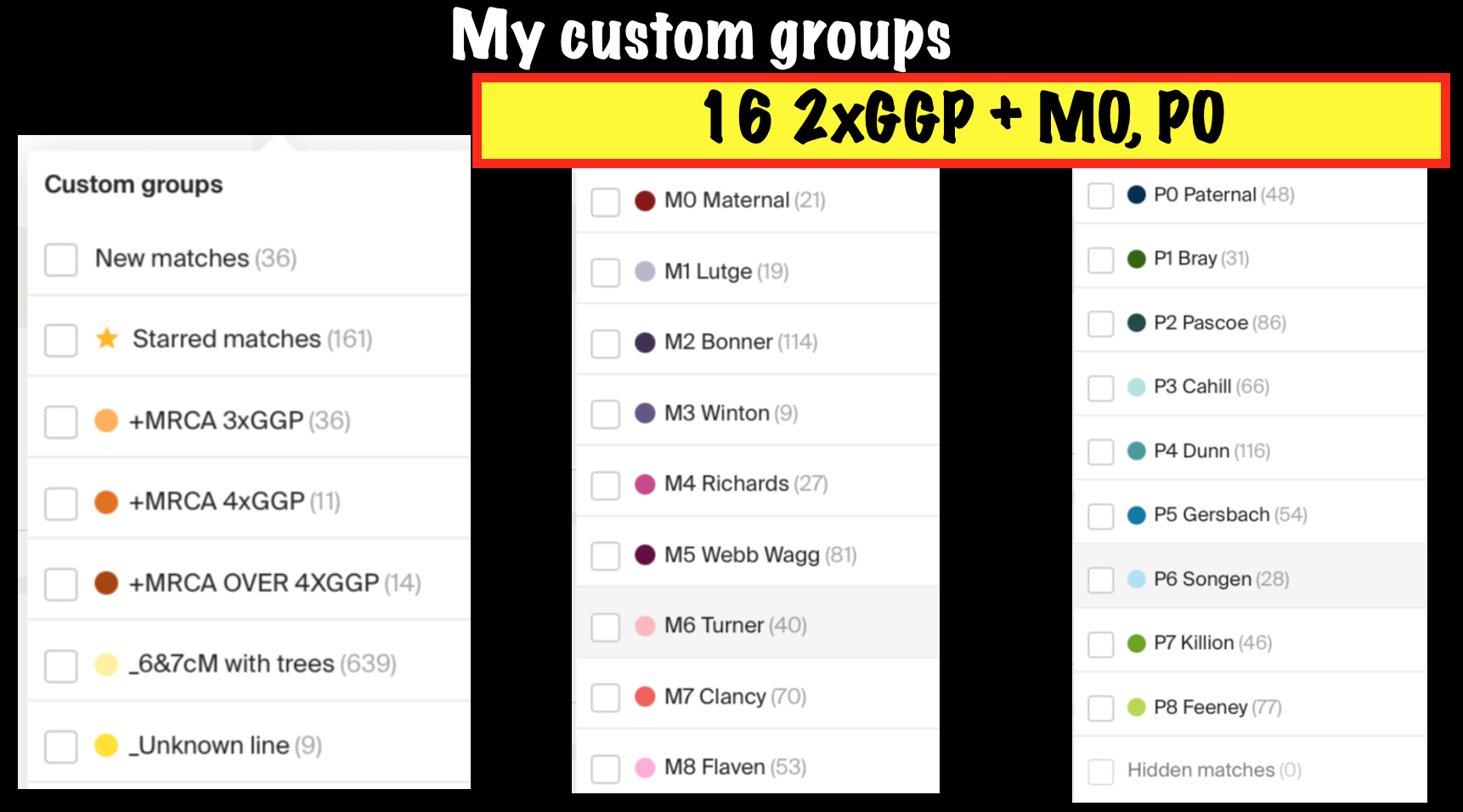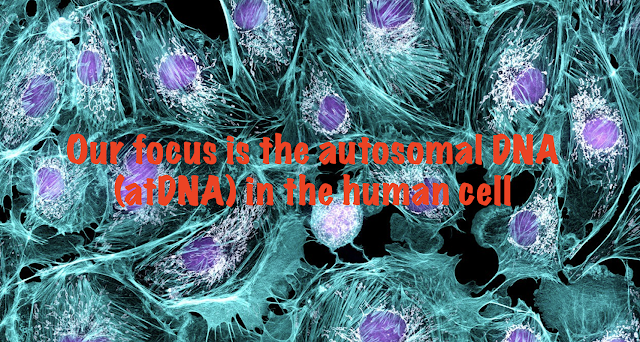MODULE 2: Grouping your AncestryDNA matches - The Leeds Method and my "twisted" Leeds Method
Introduction to the Leeds Method
Remember that many of us have two predigrees we research - our social/known family and our biological/genetic family. In 2018, a US study estimated that one in four people who take a DNA test discover an unexpected parentage event between themselves and their great grandparents ie 25% between you and your closest fourteen ancestors. Genetic genealogy is an important tool for every family historian and cannot be ignored. Knowing your tree and knowing your matches is the key to breaking down brick walls and, for many of us, there are many surprises along the way.
The Leeds Method is a process for grouping your DNA matches by using your second to fourth cousins to assign them to one or more of your four biological grandparents. Dana suggest that you commence with the first match below 400cM and work down to 70cM. I take it down to 40cM, at least, and suggest you do the same.
Grouping your matches using the Leeds Method is not 100% accurate but it’s a good start. Endogamy, close relationships (like two brothers marrying two sisters) and small matches are hard to correctly categorise. However, I’ll guarantee you that you’ll always learn something from using the Leeds Method.
The Leeds Method is easy to prepare and is a visual guide that can help everyone who takes a DNA test. I’ve used it for adoptees, people searching for biological fathers, grandparents and as far back as 2nd great-grandparents with success. If your can't get your four grandparents now, keep grouping your matches as they come along for breakthroughs or find people who are prepared to test. Once you have your grandparents, you can group further back. I group to my 2nd great-grandparents.
You may have matches or groups of matches that you can't fit into an ancestral line. You can then investigate these matches to see if you can find MRCAs amongst groups of matches and how they might fit into your ancestral line. Remember that you must prove your pedigree at each generation and there could be cases of misattributed parentage for you and/or the matches. Always be openminded as we know DNA doesn't lie but we need to know how to interpret it.
The Leeds Method works well when you're unsure of the relationship with any of you DNA matches. So it's an ideal tool for adoptees. What if, thought your family relationships and traditional research, you know some of your DNA matches?
This is where my "twisted" Leeds Method is used.
I'll present the approach and grouping method I've used successfully but you can use any grouping system that suits you provided you're systematic in it's use.
Setting up AncestryDNA for grouping
- upload or build a searchable public or private tree at Ancestry,
- take your tree back to your grandparents, at least, if known,
- record any unknown ancestors in your pedigree tree as "Unknown" or "_____" and
- attach your AncestryDNA test to the tree.
Why use AncestryDNA groupings?
- Grouping AncestryDNA matches
- Building private, unsearchable "quick and dirty" research trees at Ancestry looking for Most Recent Common Ancestors (MRCAs) for your matches
- Developing "What are the Odds?" (WATO) trees at DNAPainter to record your findings
Developing your groups
- Think about how you want to set up your groupings
- Different goals require different groupings
- Groups can be edited or deleted at any time
- Trial and error is a good way to learn
- There’s always someone to give you a hand
- Primary groupings are the ancestral P and M groups
- Additional research or focus groups can be used up to a total of 24
Key message: ORGANISE YOUR GROUPS SYSTEMATICALLY!
AncestryDNA's SideView
Scenario 1 - Who are my biological parents?
- Go to the first match below 400cM, assign the match to a group and assign all the shared matches to the same group - don’t worry if matches end up with multiple dots
- Then do the same for the next ungrouped match down to 40cM - don’t worry if matches are in more than one group
- Now go back to the first group, examine trees and see if you can find MRCAs using “quick and dirty” research tree
- Prepare a WATO tracking matches to MRCAs
- Repeat the process for each group while looking for cross over of groups
- Can be a long process to resolve the pedigree……
Scenario 2 - Who's my father?
Goal is to find biological father-
- by dividing DNA matches into potential paternal and maternal lines
- using known maternal matches and their shared matches
- to infer paternal matches.
My approach to grouping matches in this situation-
- Set up one group for the potential paternal matches (inferred as not maternal) and four groups for each of the maternal great-grandparents - P0, M1/2, M3/4, M5/6 and M7/8.
- For all matches with “Common ancestors”, verify relationship and tag to group/s - M1/2, M3/4, M5/6 and M7/8.
- For matches only tagged to one group, tag shared matches to the same group.
- For untagged matches over 70cM with trees (linked or unlinked), see if you can quickly establish maternal MRCA and tag and, if only one group, tag all shared matches to the same group.
- For untagged 3rd cousin and close matches, start at the highest untagged match and tag that person and shared matches to unknown “potential” paternal groups.
- Look at the 3rd cousin and closer “potential” paternal matches with a tree and see if you can find common family names to concentrate on that branch for the MRCA.
- When you’ve found the MRCA build them into the Q&D tree, track in WATO and tag match to MRCA group.
- Iterative process until you crack it and, if not, plan the way forward.
Scenario 3 - I know my grandparents but how am I related to all these matches?
- "prove" your genetic pedigree and
- identify MRCAs between your matches
- to break down brick walls
- by using an iterative process
- that results in your matches being grouped into your sixteen 2nd great-grandparent lines.
My approach when commencing to group matches-
- See if Parent 1 and Parent 2 can be edited to Paternal and Maternal and group to P0, M0 and UK
- Set up groups for 4 grandparents (P1/4, P5/8, M1/4, M5/8)
- For 4th cousin and closer matches with “Common ancestors”, verify relationship and tag to group/s
- For matches only tagged to one group, tag shared matches to the same group
- For untagged matches with trees (linked or unlinked), see if you can establish MRCA and tag and, if only one group, tag all shared matches to the same group
- Examine the shared matches of all untagged matches of 40cM and above to see if a group can be established and, if not, organise them into unknown groups.
- From here, you can divide the groups further until you get to the sixteen 2nd great-grandparent groups.
- Once you're confident with this method of grouping and "know" the pedigree, you can break straight to the eight great-grandparent or sixteen 2nd great-grandparent groups.
- Remember, if you don't have any tagged matches on one or more lines, you may have misattributed parentage in your pedigree.
- Also matches over 40cM that don't fit into one of your P1 to P8 and M1 to M8 groups should be explored as you may have misattributed parentage in your pedigree.
Chrome extension - Click all checkboxes
The eureka moment!
Example of that eureka moment!
Sue has matches with H1, H2, Abbie, Charlie and Bert. Grouping, researching and recording reveals-
- H1 and H2 are in the same group. When we build our "quick and dirty" tree, we find the green couple are their MRCAs. They are first cousins 1x removed on the green line.
- H1 and Abbie are in the same group. When we build our "quick and dirty" tree, we find the blue couple are their MRCAs. They are second cousins 1x removed on the blue line.
- H2 is in the same group with Charlie and Bret. When we build our "quick and dirty" tree, we find the pink couple are their MRCAs. H2 and Charlie are first cousins 2x removed on the pink line. H2 and Bert are third cousins on the pink line.
Suggested groupings for close relatives
Start from your highest unknown match or group of matches to make those discoveries!
My "twisted" Leeds Method groupings
Scenario 1 - You're collaborator or manager of father's AncestryDNA test
Scenario 2 - You're collaborator or manages of mother's AncestryDNA test
Scenario 3 - You're collaborator or manager of father's and mother's AncestryDNA tests
Scenario 4 - You're collaborator or manager of first cousin's AncestryDNA test
Scenario 5 - You're collaborator or manage of second cousin's AncestryDNA test
A few final comments
- At the 30 July 2020 session, there was a question about the lack of maternal matches on AncestryDNA as the participants mother was from Holland. My first suggestion would be to upload AncestryDNA data to the other testing sites and GEDmatch.com. You can follow the same process with matches on these sites and build a picture of the matches across all sites.
- At the 30 July 2020 session, there was a discussion about using underscores rather than "Unknown" or "Private" on "quick and dirty" research trees to avoid getting hints. I only use hints when I need them and prefer "Unknown" and the family name until I get more definition. When I get to the point that I know it's one of two or more people, I will write the names there eg "Tom, Dick or Harry".
- I have a pedigree loaded on Ancestry and only look at hints for my direct line by using this tree. I only use hints in my large tree when I'm researching a particular person.
A selection of my favourite resources to assist-
- Dana Leeds: The Leeds Method of Clustering DNA Matches
- Your DNA Guide: Organising Matches with the Leeds Method
- The Family History Fanatics: Create a DNA Leeds Method Chart Quickly to Cluster Your DNA Matches
- Dana Leeds: Why do I have more than 4 clusters?
- Leeds Method: Lack of 2nd cousins can cause lots of clusters
- Ancestry: Grouping and filtering AncestryDNA matches
- Blaine Bettinger: Sub-clustering shared matches
- DNA Family Trees: How to cluster your DNA matches with Ancestry’s new DNA matches
- DNA Family Trees: How to create a family tree from your DNA matches with Ancestry’s new DNA matches
- DNA Family Trees: Sourcing your family tree with AncestryDNA
- DNA Family Trees: AncestryDNA match triangulation to find or prove your family tree
- Roberta Estes: Using Ancestry’s new match grouping dots
- Ancestry's NEW DNA match list format Reviewed!
- Genetic Genealogy Tips & Techniques
- Using DNA for Genealogy Australia & New Zealand
- DNA Detectives Down Under


































